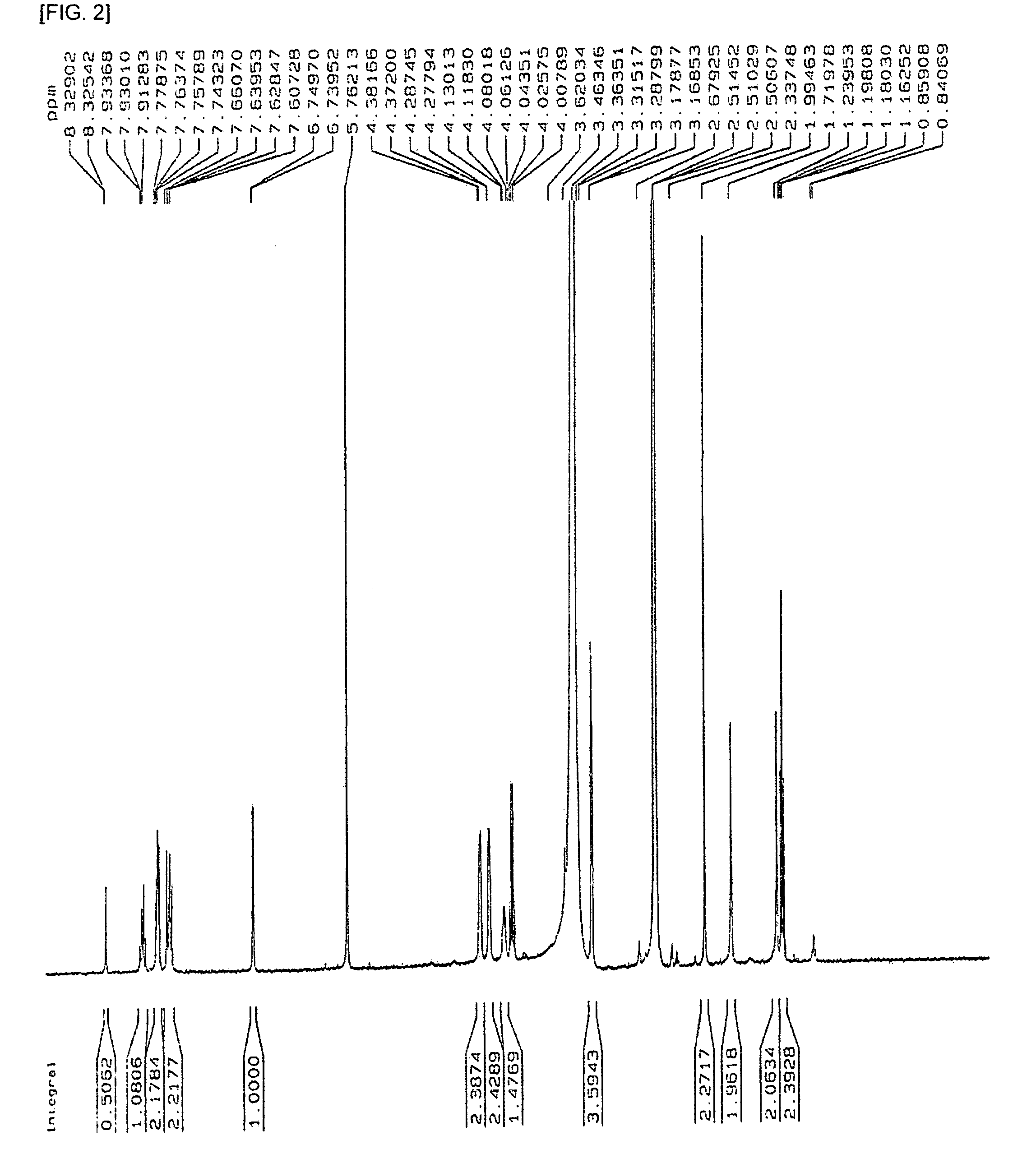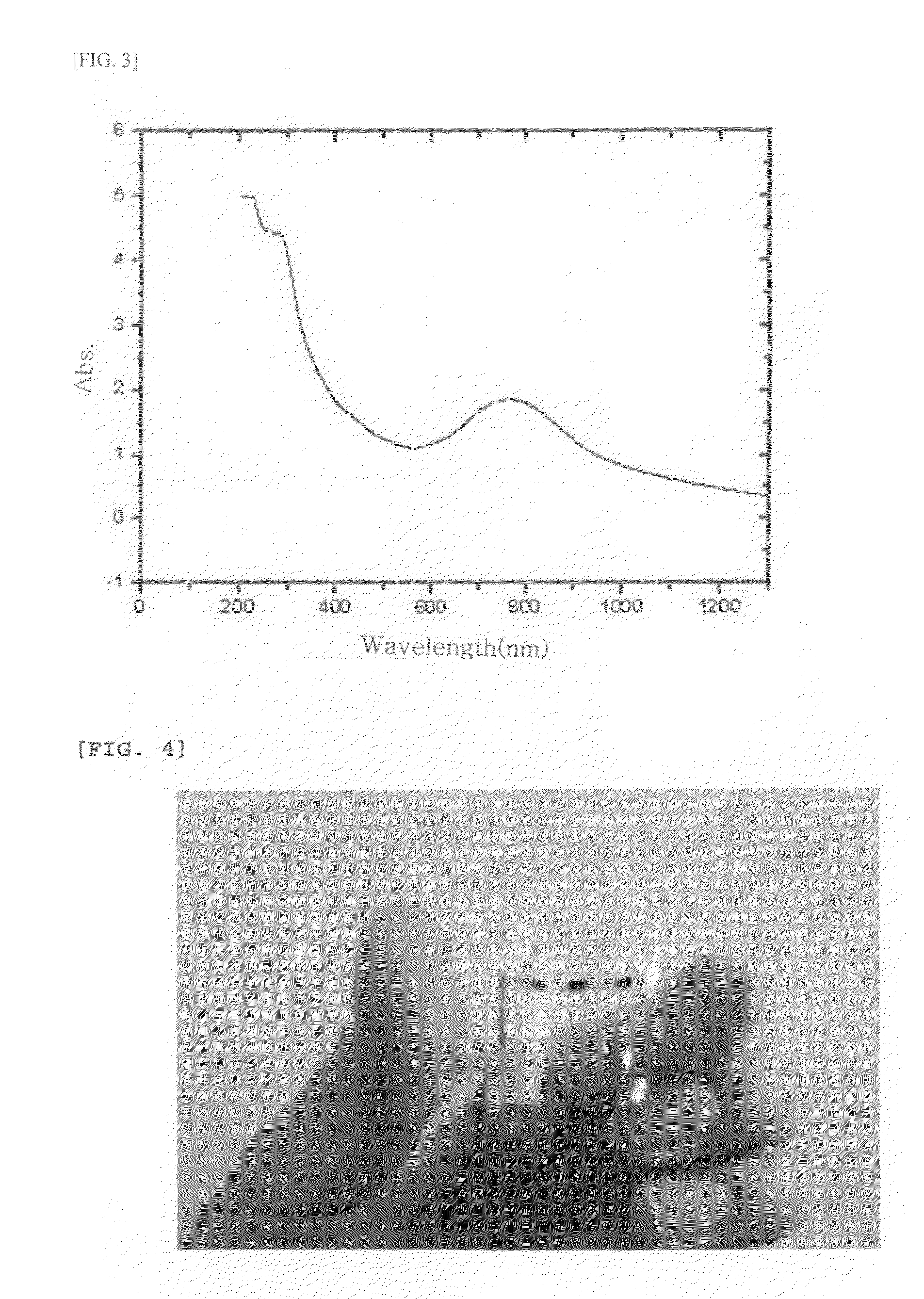Compound for molecular electronic device
a technology of electronic devices and compounds, applied in the direction of non-metal conductors, conductors, nanoinformatics, etc., can solve the problems the cost will increase by a geometric progression, and the limitation of increasing the integration degree of a semiconductor, so as to reduce the electronic short
- Summary
- Abstract
- Description
- Claims
- Application Information
AI Technical Summary
Benefits of technology
Problems solved by technology
Method used
Image
Examples
example 1-1
Preparation of Monomer
A. Synthesis of 4-trimethylsilylethynylaniline
[0033]As shown in the following Reaction 1, 300 mg (1.37 mmol) of 4-iodoaniline was melted in 5 mL of trimethylamine, and 0.20 mL (1.46 mmol, 1.07 eq) of trimethylsilylacetylene, 4 mg (0.0068 mmol, 0.5 mol %) of dichlorobis-(triphenylphosphine)palladium(II), and 2 mg (0.013 mmol, 1 mol %) of copper iodide were added thereto, and then the reaction solution was stirred under nitrogen atmosphere for 12 hours. Next, the reaction solution was filtered with ether, and was extracted with 10 mL of 2M ammonium chloride aqueous solution 2 times and with 1M sodium chloride aqueous solution 1 time. The organic solvent layer was dehydrated with magnesium sulfate, filtered, and then distilled under reduced pressure. The compound distilled under reduced pressure was purified with a column chromatography (mobile phase volume ratio; ethylacetate:n-hexane=1:4) to obtain 246 mg of 4-trimethylsilylethynylaniline with the yield of 98%. ...
example 1-2
Preparation of Monomer
A. Synthesis of 4-(trimethylsilylethynyl)benzaldehyde
[0043]As shown in the following Reaction 6, 500 mg (2.15 mmol) of 4-iodobenzaldehyde was melted in 2.7 mL of tetrahydrofuran, and 0.45 mL (3.22 mmol, 1.5 eq) of trimethylsilylacetylene, 0.6 mL (3.44 mmol, 1.6 eq) of diisopropylethylamine (DIEA), 7 mg (0.01 mmol, 0.5 mol %) of dichlorobis-(triphenylphosphine)palladium(II), and 3 mg (0.02 mmol, 1 mol %) of copper iodide was added thereto, and then the reaction solution was stirred under nitrogen atmosphere for 12 hours at room temperature. Next, the reaction solution was filtered with ether, and then was extracted with 1M sodium chloride aqueous solution 1 time. The organic solvent layer was dehydrated with magnesium sulfate, filtered, and then distilled under reduced pressure. The compound distilled under reduced pressure was purified with a column chromatography (mobile phase volume ratio; ethylacetate:n-hexane=1:10) to obtain 420 mg of 4-trimethylsilylethyny...
example 2-1
Production of Compound for Molecular Electronic Device
[0057]50 mL of 3,4-ethylenedioxythiophene was added to 1 mg of monomer obtained in Example 1-1, and 0.75 mL of styrene sulfonic acid polymer and 10 mL of water added to form an emulsion, and 0.1 g of ammonium persulfate was added thereto to produce the compound of Formula. 1, wherein the single molecule having an electrical conductivity (R) was
[0058]
and the repeating unit of polymer parts having an electrical conductivity (M) was
[0059]
By comparing the viscosity of the obtained compound with the viscosity of polyaniline of a known molecular weight, it is found that the polymerization degree (n) of the polymer parts of the obtained compound was 100 to 500 according to the polymerization condition. Also, the absorbance of the obtained compound was measured with UV-Near IR, and the result is shown in FIG. 3. As shown in FIG. 3, the tail peak of long wavelengths (more than 900 nm), which was generally produced when PEDOT (poly(3,4)eth...
PUM
| Property | Measurement | Unit |
|---|---|---|
| size | aaaaa | aaaaa |
| temperature | aaaaa | aaaaa |
| temperature | aaaaa | aaaaa |
Abstract
Description
Claims
Application Information
 Login to View More
Login to View More - R&D
- Intellectual Property
- Life Sciences
- Materials
- Tech Scout
- Unparalleled Data Quality
- Higher Quality Content
- 60% Fewer Hallucinations
Browse by: Latest US Patents, China's latest patents, Technical Efficacy Thesaurus, Application Domain, Technology Topic, Popular Technical Reports.
© 2025 PatSnap. All rights reserved.Legal|Privacy policy|Modern Slavery Act Transparency Statement|Sitemap|About US| Contact US: help@patsnap.com



